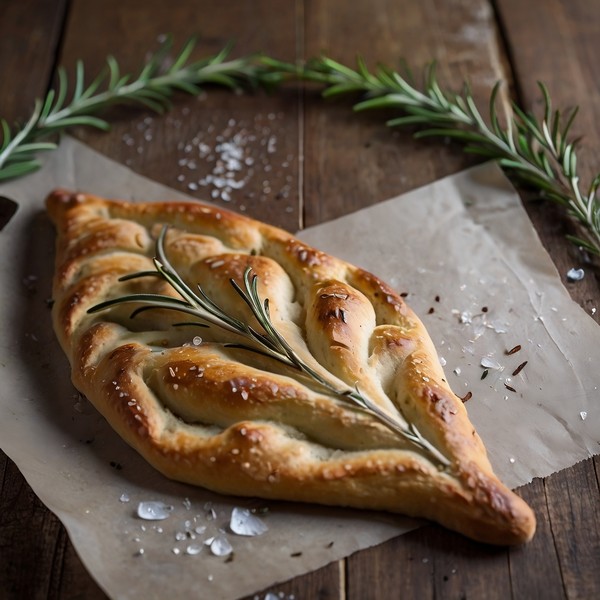Fougasse (French-Style Flatbread)

Hailing from the sun-drenched regions of southern France, the fougasse is a visually striking edible masterpiece, a rustic cousin to the beloved focaccia that tantalizes the senses with its ornate patterns and savory aromas.
Marthinus StrydomThe Story
The fougasse traces its origins to the rustic bakeries of Provence in southern France, where bakers have been crafting these artistic breads for centuries. The name derives from the Occitan word "fougasso," meaning a flat cake. In the past, fougasse dough was often used by bakers to test the heat of their wood-fired ovens before baking more intricate breads. As the bakers gained skill, they began shaping the dough into leaf patterns or intricately slashing the top to create designs that allowed the bread to bake with a beautifully crackled crust. While first baked as a humble oven tester, the fougasse evolved into an edible folk art form, with each village developing its own traditional designs and flavors. Today, it remains an iconic bread of Provençal cuisine, delighting visitors and locals alike with its stunning appearance and rich, satisfying flavor.

Subscripe to my Facebook page.
Subscripe to my Youtube channel.
© All recipes are copyright protected by TheCultureCook.com unless the recipe was adapated from another source. All recipes are uniquely crafted and adapted by TheCultureCook.com. Copyright of some or all of the text reside with the original author.
Ingredients
Method
- Grease a large bowl with olive oil.
- Combine all-purpose flour, spelt flour, yeast, and kosher salt in the bowl of a stand mixer fitted with a dough hook. Add water and knead until dough is smooth, elastic, wet, and sticky, about 5 minutes. Transfer dough to the prepared bowl. Cover and let rise on the counter for 30 minutes.
- Uncover the dough. Wet one hand and grab one side of the dough in the bowl. Pull it up slightly and fold it in towards the center. Repeat this folding technique 6 or 7 more times, turning the bowl slightly in between each fold. Cover and let rest for 30 minutes.
- Repeat Step 3 (above) two more times. Dough will have rested for a total of 2 hours.
- Repeat folding technique once more. Cover and place in the refrigerator for 12 to 24 hours.
- When ready to bake, line a sheet pan with a silicone liner; sprinkle some flour on the liner.
- Transfer dough to a lightly floured surface and pat or press it into an oval shape, flouring lightly as necessary. Cut the oval in half lengthwise into two equal portions.
- Shape fougasse: On one piece of dough, fold one end in over the center third, then fold the other end in over top. Dough should resemble a triangle. Transfer dough to the prepared pan. Repeat with the second piece of dough.
- Cover both triangles with an oiled piece of plastic wrap and let sit until dough warms up, 30 minutes to 1 hour.
- Line two baking sheets with parchment paper; generously sprinkle cornmeal on the parchment. Remove plastic from the dough.
- Transfer one piece of dough to a lightly floured surface. Sprinkle some flour over top and use a rolling pin and your hands to stretch the triangle until it's 1-1.5 cm thick. Sprinkle rosemary over top and press it into the dough. Transfer dough to one of the parchment-lined baking sheets.
- Use a pizza wheel to cut through the dough in a vertical line up the center of the triangle; do not cut through the top and bottom edges. Pull dough apart to spread open the cut.
- Make two more cuts at the top, one on each side from the center going out toward the edge, making sure you don't cut through the edges. Pull dough gently to spread it out. Make four more cuts, two in the middle, and two at the bottom, and pull dough apart. Make two more small cuts at the bottom. You will have one long cut in the center and 4 going down each side, so the fougasse will resemble a leaf. Cover with oiled plastic wrap and let proof for 30 to 60 minutes.
- Repeat Steps 6 to 8 (above) to shape and proof the remaining dough.
- Preheat the oven to 230 degrees C. Remove plastic wrap from one fougasse. Brush olive oil over the entire surface and sprinkle with sea salt.
- Bake in the center of the preheated oven until beautifully browned, about 20 minutes.
- Transfer to a rack to cool. Repeat Steps 11 and 12 (above) to bake remaining fougasse.
- Serve and enjoy.
